
Gustave Dore Dante and Virgil among the gluttons 1868

Worldometer reports new cases for June 9 (midnight to midnight GMT+0) at + 132,786 (yesterday was updated to 141,973).
My count from about 6 am EDT to 6 am EDT is + 131,902 cases. Remember: it’s weekend.
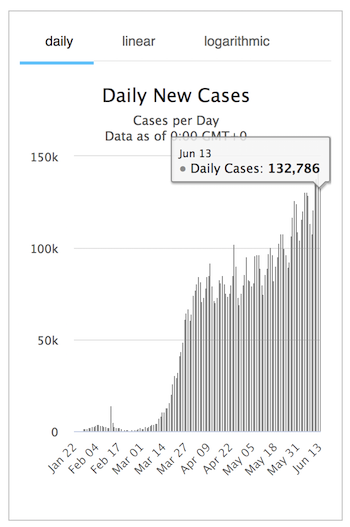

New cases past 24 hours in:
• US + 28,487
• Brazil + 23,468
• Russia + 8,835
• India + 12,360
• Pakistan + 6,825
• Chile + 6,509

• Cases 7,895,777 (+ 131,902 from yesterday’s 7,763,875)
• Deaths 432,882 (+ 4,148 from yesterday’s 428,734)

US yesterday 25,396, high in recent times. 8 states report new highs, including significant jumps (attached): FL, NC, AZ, AL, SC, AK, OK, and MS, which may be data issue. pic.twitter.com/r88OqbNt3T
— Yaneer Bar-Yam (@yaneerbaryam) June 13, 2020

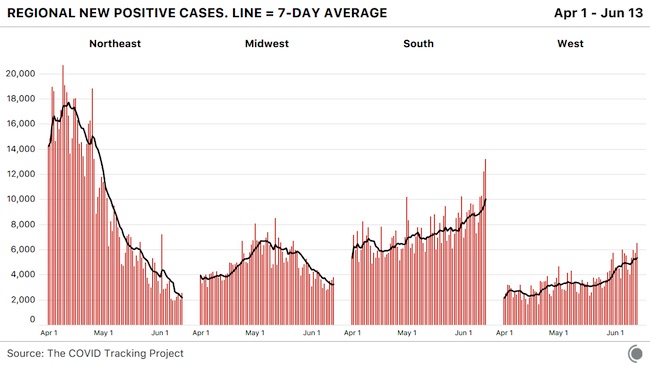

This is scary. 50% of asymptomatic SARS-CoV-2 patients had abnormal lung CT scans. https://t.co/LvDKnoNsXQ
— Mark Budde (@markwbudde) June 13, 2020

From Worldometer yesterday evening -before their day’s close-:
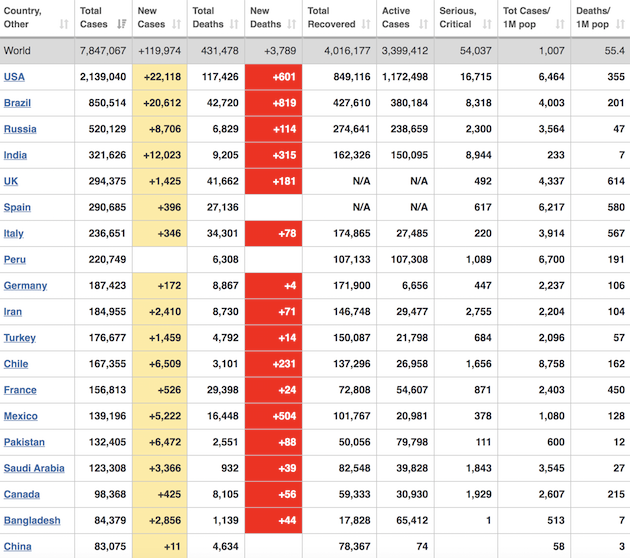
From Worldometer:
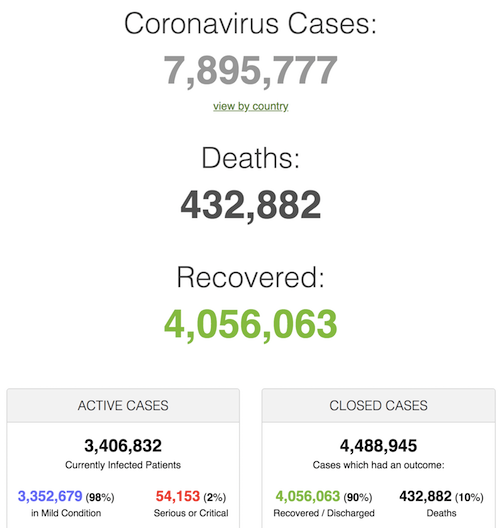
From COVID19Info.live:
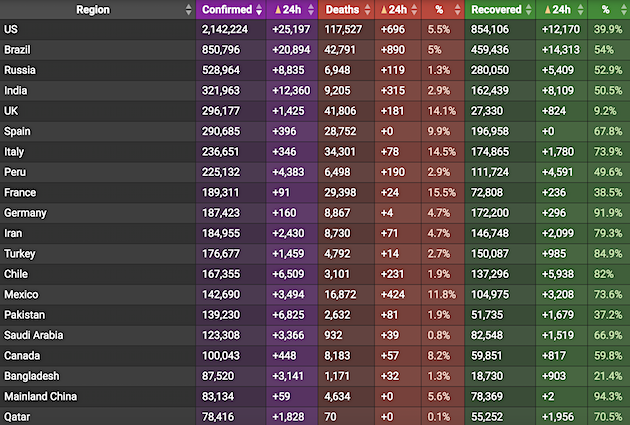
“The number of whites who were enslaved in North Africa by the Barbary pirates exceeded the number of Africans enslaved in the United States and in the American colonies before that put together.”
Thomas Sowell on reparations: pic.twitter.com/wJCkiZtLri
— Thomas Sowell (@ThomasSowell) June 10, 2020

..a new outbreak has been linked to a meat and vegetable market in south Beijing..
• China Reports 57 New Confirmed, 9 Asymptomatic COVID-19 Cases For June 13 (R.)
China reported 57 new confirmed COVID-19 cases for June 13, the highest since April 13, according to data released by the national health authority on Sunday. The National Health Commission said in a statement that 38 of the new confirmed cases were locally transmitted, with 36 of them in Beijing. This is the highest daily infection count for China’s capital since authorities started releasing data. Beijing recorded a jump in new confirmed cases, up from six a day earlier, after it started doing mass-testing at the Xinfadi market in the city’s southwestern Fengtai district.
The district has put itself on a “wartime” footing and the capital banned tourism and sports events on Saturday, sparking fears of a new wave of COVID-19. Nineteen of the new confirmed cases were so-called imported cases involving travellers from overseas, with 17 of them arriving in Guangdong. China also reported nine asymptomatic cases, one new suspected case and no new deaths from COVID-19 for June 13. The total number of COVID-19 cases in mainland China now stands at 83,132, while the death toll remained unchanged at 4,634. China does not count asymptomatic patients, who are infected with the virus but do not display symptoms, as confirmed cases.
All 17 persons are Chinese managers in shoe and textile manufacturing in Bangladesh. There might also be a forced decoupling of China and the developing world. https://t.co/LOf3H8BqBp
— Ben (@benjaminqiu) June 14, 2020

https://twitter.com/DrEricDing/status/1271988040169328641
• Clusters of Coronavirus Disease in Communities, Japan, January–April 2020 (CDC)
We investigated clusters of COVID-19 cases and probable primary cases in Japan during January 15–April 4, 2020. We found that healthcare facilities, such as hospitals, and care facilities, such as nursing homes, were the primary sources of clusters, some of which had >100 cases. Japan experienced 2 waves of imported COVID-19 cases, after which local transmission occurred and the epidemic grew (8). Of note, clusters of COVID-19 cases at healthcare and care facilities predominated at epidemiologic weeks 11 (March 9–15) and 14 (March 30–April 4), which corresponds to ≈3 weeks after the 2 waves of imported cases (Figure 1, panel C). Healthcare and care facilities might be located at the end of the local transmission chain because clusters in those facilities only became evident several weeks after community transmission persisted.
We noted many COVID-19 clusters were associated with heavy breathing in close proximity, such as singing at karaoke parties, cheering at clubs, having conversations in bars, and exercising in gymnasiums. Other studies have noted such activities can facilitate clusters of infection (9,10). Japan’s Prime Minister’s Office and the Ministry of Health, Labour and Welfare announced 3 situations that could increase the risk for COVID-19 cases and advised the population to avoid the “Three Cs”: closed spaces with poor ventilation, crowded places, and close-contact settings (11).
Among the probable primary COVID-19 cases we identified from non-nosocomial clusters, half (11/22) were 20–39 years of age, which is younger than the age distribution of all COVID-19 cases in Japan (Figure 2, panel A). We do not know whether social, biological, or both factors play a role in the difference in transmission patterns between the younger and older persons. We also noted probable primary COVID-19 case-patients appear to transmit the virus and generate clusters even in the absence of apparent respiratory symptoms, such as cough.
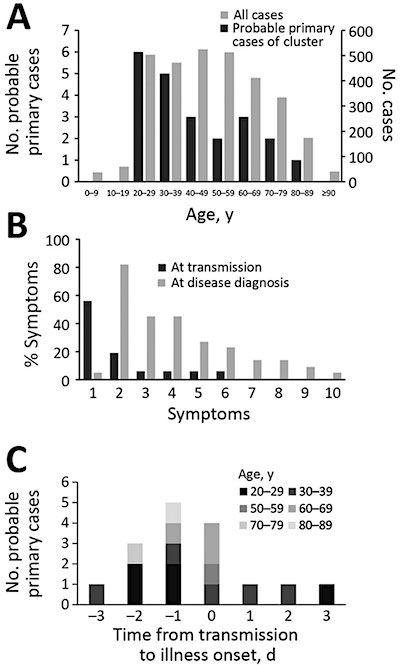
Figure 2. Analysis of probable primary cases of coronavirus disease (COVID-19) among 22 clusters in communities, Japan. A) Age ranges of probable primary COVID-19 cases in clusters. Age distribution among all COVID-19 cases in Japan is provided as reference. B) Proportions of symptoms among probable primary cases of COVID-19 clusters at transmission (n = 16) and among at laboratory confirmed diagnosis (n = 22). 1, Asymptomatic; 2, fever; 3, fatigue; 4, cough; 5, sore throat; 6, headache; 7, arthralgia or myalgia; 8, runny nose; 9, diarrhea; 10, difficulty breathing. C) Distribution of probable primary cases of COVID-19 clusters by time of transmission compared with illness onset by age groups (n = 16). Six cases were excluded because the time of transmission was undetermined.

Richard Horton’s problem today is of course, apart from his bout with cancer, that he was responsible for the entirely fake report on HCQ the Lancet published.
• The Greatest Science Policy Failure For A Generation – Lancer Editor (G.)
There is a school of thought that says now is not the time to criticise the government and its scientific advisers about the way they have handled the Covid-19 pandemic. Wait until all the facts are known and the crisis has subsided, goes this thinking, and then we can analyse the performance of those involved. It’s safe to say that Richard Horton, the editor of the influential medical journal the Lancet, is not part of this school. An outspoken critic of what he sees as the medical science establishment’s acquiescence to government, he has written a book that he calls a “reckoning” for the “missed opportunities and appalling misjudgments” here and abroad that have led to “the avoidable deaths of tens of thousands of citizens”.
The Covid-19 Catastrophe: What’s Gone Wrong and How to Stop It Happening Again is a short polemical book, building on a series of excoriating columns Horton has written in the Lancet over the past few months. He lambasts the management of the virus as “the greatest science policy failure for a generation”, attacks the Scientific Advisory Group for Emergencies (Sage) for becoming “the public relations wing of a government that had failed its people”, calls out the medical Royal Colleges, the Academy of Medical Sciences, the British Medical Association (BMA) and Public Health England (PHE) for not reinforcing the WHO’s public health emergency warning back in February, and damns the UK’s response as “slow, complacent and flat-footed”, revealing a “glaringly unprepared” government and a “broken system of obsequious politico-scientific complicity”.
On the page, Horton can sound strident, even arrogant, but that’s not his manner in person at all, at least not in our long Zoom conversation. He’s charming, open, self-critical and full of easy laughter. I suggest that, as bad as things look at the moment, surely people like the chief medical officer, Chris Whitty, and the chief scientific officer, Patrick Vallance, have been doing their best. “Individually, they’re great people,” he says. “I’m not criticising individuals, but the system was a catastrophic failure.” As editor of the Lancet, he’s particularly aggrieved that the series of five academic papers the journal published in late January first describing the novel coronavirus in disturbing detail went unheeded. “In several of the papers they talked about the importance of personal protective equipment,” he reminds me.
“And the importance of testing, the importance of avoiding mass gatherings, the importance of considering school closure, the importance of lockdowns. All of the things that have happened in the last three months here, they’re all in those five papers.” He still can’t understand why the government’s scientific advisers didn’t consult their counterparts in China. The world of medicine is a small one, he says, and everyone knows the people responsible for coordinating the Chinese government’s response. “These are people they could have literally sent an email to, or picked the phone up to, and said, ‘Hey, we read your paper in the Lancet, can it really be as bad as that? What is going on in Wuhan?’ And if they’d done that they would have found out that this was indeed as bad as described.”

Whereas Jerry Nadler’s problem is that his candidate, Joe Biden, has spoken out against Medicare For All. Wait, Nadler knows that; is he trying to embarrass Biden?
• Nadler: ‘Eliminating’ Private Insurance Could Pay For ‘Medicare For All’ (JTN)
Rep. Jerry Nadler (D-N.Y.), chairman of the House Judiciary Committee, suggested Friday that Congress could pay for a “Medicare for all” health care system without raising taxes by eliminating private insurance entirely. During a discussion with the Medicare for All Caucus, Nadler repeated some of the objections that critics of single-payer health care have raised including, “How are we going to pay for it?” and “We’re gonna have to raise taxes and all.” Nadler recommended that Democrats stop engaging in the tax increase debate.
“The entire mechanism, half a trillion dollars a year of private insurance, and not only the money for the profits, but the money for the markets segmenting; the money for the entire administration that all the insurance companies do; the money that all the hospitals and the doctors have to spend to deal with the bureaucracy of insurance companies – that’s half a trillion dollars a year, all of which could be spent on medical care, instead of being spent on either profits or just administrative costs,” Nader said during the discussion.
“It’s a huge amount of money and we could institute a Medicare for all system without increasing taxes. I mean, that’s not a discussion we have to get into because the cost savings from just eliminating the private insurance leech on the system would pay for all of Medicare for all, all the services, everything we’re talking about and when we get to debating this on a political level, again, we ought to be emphasizing that,” he added. Nadler urged Democrats to begin making his argument in favor of Medicare for all on the campaign trail in this election cycle. “I don’t understand why we didn’t point this out enough and we must in the future,” he said. Such an argument will continue to face strong opposition from the country’s estimated $900 billion private insurance industry and those opposed to a completely government-run health care system.

More Nadler. He and Schiff will simply say they had every right to do the probe, and lost only because the Senate is partisan. Just like Congress is, but for the other party.
• Congress Spent $3.06 Million On Failed Impeachment Probe (JTN)
The Golden Horseshoe is a weekly designation from Just the News intended to highlight egregious examples of wasteful taxpayer spending by the government. The award is named for the horseshoe-shaped toilet seats for military airplanes that cost the Pentagon a whopping $640 each back in the 1980s. This week, our award is going to the the United States Congress for spending $3.06 million in taxpayer dollars between September and December 2019 on the failed impeachment of President Trump. The recently released openthebooks.com report entitled “Congressional Membership Has Its Privileges: Salaries, Pensions, Travel & Other Taxpayer-Funded Perks” breaks down some of the exorbitant annual costs of the nation’s legislative branch.
The oversight report, which is published annually under the Federal Funding Accountability and Transparency Act of 2006, was initially sponsored by the late Senator Tom Coburn (R-Okla.) and then-Senator Barack Obama. According to this year’s analysis, during the period between Sept. 24 2019, when House Speaker Nancy Pelosi declared an impeachment inquiry, and Dec. 13, 2019, when the House Judiciary Committee sent two articles of impeachment to the Senate, the lower chamber ran up a bill to taxpayers of over $3 million. That price tag included the salaries of more than 100 congressional staffers and employees who, for those four months, essentially worked full-time on the impeachment proceedings.
It also factors in the hourly fees of the six attorneys who were hired as lawyers of record for witnesses who made appearances during hearings, and acted as impeachment counsel for the House Democratic impeachment managers throughout the trial. The high cost of the impeachment effort is primarily due to the House’s decision to use congressional staffers to investigate the president for potentially impeachable crimes. For reference, during the impeachment of President Clinton 1998, the majority of the fact-finding was done by Independent Counsel Ken Starr’s staff. For President Nixon’s impeachment inquiry, the bulk of the investigating was handled by special prosecutors Archibald Cox and Leon Jaworski, in addition to a Senate select committee.

Nutshell: the Fed hands Goldman Sachs buckets full of billions to aid it in selling off the US to China for profit.
• How Beijing Cultivated Wall Street’s Giants (SMH)
In November 2018 Peter Navarro, the White House trade adviser who at the time was intimately involved in President Trump’s trade war with Beijing, launched a scathing attack on what he called the “globalist billionaires” of Wall Street. He accused the “self-appointed group of Wall Street bankers and hedge fund managers” of engaging in their own “shuttle diplomacy” with the Chinese side and attempting to sabotage US trade negotiations by putting enormous pressure on the White House to give way to Beijing. Navarro further accused the financial elite of being “unregistered foreign agents” acting as part of Beijing’s influence operations in Washington. It was strong stuff, but was there any foundation to it?
Beijing has been working on Wall Street for a long time. When Prime Minister Zhu Rongji visited the United States in 1999, he holed up in New York’s Astoria Hotel and spent days in back-to-back meetings with business leaders. “Zhu seems never to tire of courting Corporate America,” reported The New York Times. The titans of US finance have for decades been guiding the nation’s China policy. Whenever presidents Clinton, Bush or Obama threatened to take a tougher stance on China’s trade protectionism, currency manipulation or technology theft, Wall Street chiefs used their influence to persuade them to back off. And it was pressure from Wall Street that proved decisive in the Clinton White House’s decision to support China’s admission to the World Trade Organisation, despite China’s serial violation of trade rules.
Twenty years later, The New York Times was writing: “In Washington, on Wall Street and in corporate boardrooms, Beijing has used the country’s size and promise for decades to quell opposition and reward those who helped its rise.” Financial institutions have been Beijing’s most powerful advocates in Washington. The finance sector – the big banks, hedge funds and investment vehicles – is thus in the centre of the map of power in the US, and occupying pride of place is Goldman Sachs. No organisation has been more important to the CCP’s campaign to penetrate US elites, or more willing. For the CCP, titans of finance are easy targets, as there’s a concordance of interests.
Wall Street executives, anticipating an Eldorado when Beijing opens up its vast finance markets to foreigners, have been advising Chinese companies about which American companies to buy and lending them the money to do it, taking a cut from the sales. In the words of a senior White House official, “people who like making deals really like the Chinese Communist Party”. The CCP is pushing on an open door. But the alignment of interests may not be long term, as it’s Beijing’s intention to eventually make Shanghai the financial capital of the world, displacing New York and the City of London. As Lenin reputedly said: “The capitalists will sell us the rope with which we will hang them.”
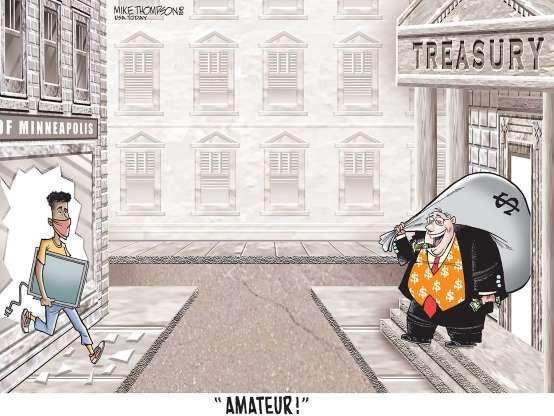

The markets gain a trillion on the responses to a few questions of 41,000 Americans. You get what you deserve.
• The Truth About The May Jobs Report (Axios)
The responses of fewer than 41,000 people were used to determine a major part of last month’s U.S. unemployment rate, the Bureau of Labor Statistics tells Axios. That’s the lowest number in modern history and is one of many unusual developments in government data collection that have affected important readings for months. The surprises in May’s nonfarm payrolls report, which found there were only 21 million unemployed while 30 million Americans were collecting unemployment insurance benefits, were largely the result of oddities in data collection. A portion of the jobs report is determined by a household survey in which government workers interview people at their homes and determine whether any person over the age of 16 is “employed, unemployed, or not in the labor force” — the only three possible designations.
The coronavirus pandemic has “depressed” survey responses since March, as BLS stopped conducting in-person meetings, restricting its ability to reach new households, Julie Hatch Maxfield, BLS associate commissioner for employment and unemployment statistics, tells Axios. “The first month of the sample we get a lot of information and that sets up the whole thing going forward,” she says. This has taken the response rate from 82% in January to 73% in March to 67% in May. “Response rates probably will be depressed even when interviewers go back into the field,” Maxfield notes. In May, BLS identified 9 million people who had lost their jobs but were counted as “not in the labor force” rather than unemployed because they hadn’t been searching for a job in the last four weeks due to the pandemic.
If those people were considered unemployed it would have taken the unemployment rate to 17.9%. A similar calculation would have put the unemployment rate at 19.8% in April and 7.5% in March, BLS says in a report about the coronavirus pandemic’s impact on its data. A separate “misclassification error” categorized millions of workers who had been absent and likely lost their jobs as employed. Additionally, workers who were paid by their employer for any part of the pay period including the 12th of the month were counted as employed, even if they weren’t actually at their jobs.

Too much power. Take it away.
• Twitter Reinstates Zerohedge After Admitting It Made An “Error” (ZH)
133 days after Twitter “permanently” banned Zero Hedge on January 31, the social network has reinstated us after admitting it made an error. As a reminder, what happened in late January was confusing. Shortly after we asked if “This [Is] The Man Behind The Global Coronavirus Pandemic”, referring to Wuhan Institute Of Virology scientist Peng Zhou (who three months later was being investigated by western spy agencies for his role in creating Covid) and some low-grade “reporter” from Buzzfeed decided to report us to Twitter for “doxxing” Zhou using publicly available information, Twitter told us that the account had been suspended for “violating Twitter rules against abuse and harassment”, which was false as we neither incited abuse nor harrassment, but merely asked questions.
But the confusing part is that at the same time, Twitter fabricated an entirely different explanation for its decision when speaking to outside media, telling them the suspension was due to “platform manipulation” – whatever that means. An odd mix of conflicting explanations but in any case, neither was true as we said at the time, and as we further told Bloomberg, the suspension was “unjustified, and likely motivated by reasons other than the stated ones” adding that “we are confident that we did not violate any of the stated Twitter terms: we neither incited harassment, nor did we ‘dox’ the public official, whose contact information is as of this moment listed on the Wuhan institute’s website.”
Fast forward to late Friday night, when unexpectedly we received a brief email from Twitter Support informing us that “we made an error in our enforcement action” as a result of which “we have unsuspended your account.” Speaking to Bloomberg, a Twitter spokesperson said that “we made an error in our enforcement action in this case. Based on additional context from the account holder in appeal, we have reinstated the account. We have a dedicated appeals process for all account holders.” Funny how mistakes happen when you ban first and ask questions later (and only when prompted to do so). In any case, no bad blood right – honest mistake? Well, not really: before all this happened, none other than Twitter’s CEO was following us.
Not anymore. The @zerohedge account also remains highly shadow banned (try searching for the actual zerohedge account on twitter, good luck), perhaps as an innocuous consequence of the “error.” That’s OK though, we never expected an apology. We are just glad that we will be able to share facts and perspectives with our now 700K Twitter followers, a number which has spiked by more than 30K in just the past few hours since the suspension was overturned.

The Flynn hearing ended in a delay, but these wheels will churn on.
• Finishing Touches Being Put On 10 New Criminal Referrals in Russia Probe (JTN)
Congressional Republicans are putting the finishing touches on as many as 10 new criminal referrals asking the Justice Department to investigate key figures in the Russia probe for misconduct ranging from perjury to illegal leaking of classified information, officials told Just the News. The referrals have been spurred by recently declassified evidence that provided explosive new revelations about the conduct of investigators in the now-disproven Russia collusion case, including documents showing FBI agents planned to shut down their investigation of former Trump National Security Adviser Michael Flynn for lack of evidence in January 2017 before they were overruled by superiors.
Other newly released evidence showed numerous Obama administration officials engaged in unmasking Flynn’s name in secret intelligence intercepts during the transition period after the 2016 election and uncovered conflicts in testimonies previously given by former top FBI and intelligence community officials. “Congress is days away from making multiple criminal referrals to DOJ related to conspiracies against Michael Flynn, crimes committed during the conduct of Crossfire Hurricane, false testimony to Congress by top Obama officials, and criminal leaks of classified information from the top rung of the IC,” said a source with direct knowledge of the referrals. The planned referrals come as the Justice Department has expanded its own criminal investigation into the conduct of current and former employees during the Russia probe.
Attorney General William Barr said this week the investigation is looking at why the FBI tried so aggressively to open and sustain an investigation into Trump’s campaign before the 2016 election when it lacked the sort of evidence to justify it, and whether those efforts amounted to conspiracy to defraud the courts or violate the rights of some of the Americans that were targeted. “I think before the election I think we were concerned about the motive, the force behind the very aggressive investigation that was launched into the Trump Campaign without — you know, with a very thin, slender reed as a basis for it,” Barr told Fox News. “It seemed that the Bureau was sort of spring-loaded at the end of July to drive in there and investigate a campaign. And they — there really wasn’t much there to do that on.”

Julian is not completely shut off from the world. Good.
• Julian Assange Just Called (Varoufakis)
Julian called me a little earlier on, at 14.22 London time to be precise. From Belmarsh High Security Prison of course. This is not the first time but, as you can imagine, every time I hear his voice I feel honoured and moved that he should dial my number when he has such few and far between opportunities to place calls. “I want a perspective on world developments out there – I have none in here”, he said. Which, of course, placed a considerable burden on me to articulate thoughts on capitalism’s fate during this pandemic and the repercussions of it all on politics, geopolitics etc. The knowledge that Her Majesty’s Prison authorities would discontinue our discussion at any moment made the task harder.
In a feeble attempt to paint a picture for him on as broad a canvass as possible, I shared with Julian my main thought of the last weeks: Never before has the world of money (i.e. the money markets, that include the share markets) been so decoupled from the world of real people, real stuff – from the real economy. We watch in awe as GDP, personal incomes, wages, company revenues, businesses small and large, collapse while the stock market is staying relatively unscathed. The other day, Hertz declared bankruptcy. When a company does this, its share price goes to zero. Not now. In fact, Hertz is about to issue $1 billion worth of new shares. Why would anyone buy shares of an officially bankrupt company?
The answer is: Because central banks print mountain ranges of money and give it for almost free to financiers to buy any piece of junk floating around the stock exchange. “Complete zombification of the corporations”, is how I put it to Julian. Julian commented that this proves that governments and central banks can keep corporations afloat even when they sell next to nothing at the marketplace. I agreed. But, I also pointed out a major conundrum that capitalism faces for the first time. It is this: Central bank money printing keeps asset prices very high while the price of ‘stuff’ and wages fall. This disconnect can go on growing.
But, when Hertz, British Airways etc. can survive in this manner, they have no reason not to fire half the workforce and to cut the wages of the other half. This creates more deflation/depression in the real economy. Which means that the Central Banks must print more and more to keep asset and share prices high. At some point, the masses out there will rebel and governments will be under pressure to divert some income to them. But this will deflate asset prices. At that point, because these assets are used by corporations as collateral for all the loans they take out to stay afloat, they will lose access to liquidity. A sequence of corporate failures will commence under circumstances of stagnation. “I don’t think capitalism can easily survive, at least not without huge social and geopolitical conflicts, this conundrum”, was my conclusion.
Julian thought about this for a moment and asked me: “How important is consumption to capitalism? What percentage of GDP is at stake if consumption does not recover? Do the corporations need workers or customers?” I answered that it was high enough to make this conundrum real. Yes, Central Banks and robots can keep the corporations going without customers or workers. But, robots cannot buy the stuff they produce. So, this is not a stable equilibrium. The losses in people’s incomes will accelerate, thus generating pivotal discontent.

We try to run the Automatic Earth on people’s kind donations. Since their revenue has collapsed, ads no longer pay for all you read, and your support is now an integral part of the interaction.
Thank you.

https://twitter.com/i/status/1271806010416607232

#TrumpIsNotWell is trending but liberals just nominated this guy: pic.twitter.com/5KTAkGdlL5
— Kayla (@RealKaylaJames) June 14, 2020

Debate moderators this fall will be asking each candidate to drink a glass of water unaided, pronounce a four-syllable word, and name three animals beginning with "G." https://t.co/pwPXDtuE00
— Matt Taibbi (@mtaibbi) June 14, 2020

Support the Automatic Earth in virustime.







